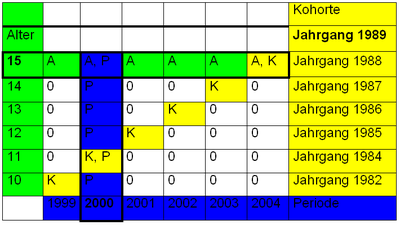Cross section (empirical research)
| Categories of patient-oriented studies |
|---|
|
In the empirical research we speak of a cross-section (e.g., T. English Cross-sectional data ), from a cross-section (s) study , cross-sectional study , cross-sectional analysis or a cross-sectional design if an empirical study (e.g., a survey or content analysis ) is carried out once . In contrast to the cross-sectional design, a longitudinal study is carried out several times in a row.
definition
In a cross-sectional study in the field of psychology, the approaches of participants of different ages are compared with each other at a fixed point in time. In these samples, age and point in time are defined as independent variables, while the recorded values are recorded as dependent variables. However, in the cross-sectional design, an age difference between two samples cannot necessarily be traced back to the underlying development processes, since a cohort effect could possibly exist here . Nevertheless, the cross-sectional method can be used to obtain initial heuristic clues for development phenomena without the need for a longitudinal investigation .
Empirical Social Research
A basic distinction is made between cross-sectional and longitudinal investigations. The variables of the cross-sectional survey can only be observed and compared at a single fixed point in time. This creates social “snapshots” of currently valid facts, opinions or behavior. During cross-sectional design used was random sampling , to the representativeness to ensure. A longitudinal analysis can be carried out in order to carry out process analyzes in which the changes in the variables are to be evaluated over a certain period of time.
One advantage of the cross-sectional method is, for example, that a one-off point in time must be taken into account for data collection and that the period from the start of the investigation to the evaluation of the results can be kept short. For a one-off examination, it is easier to find test subjects who are willing to take part in the study, while other unforeseen factors can play a role in analyzes over a longer period of time, such as the death of a participant. A disadvantage of the one-off data collection is in particular that no information about individual development processes or changes in behavior can be read. Possible differences when comparing two age groups cannot be clearly assigned to the age effect, since social conditions may have changed in the period between the studies. The result of the study is therefore only valid for the time of the survey and cannot generally be transferred to other times.
| example |
| - A: Age effect: At the age of 15, everyone buys e.g. B. a building society loan agreement |
| - P: Period effect: in the year 2000 everyone bought e.g. B. a 2000 calendar and cross section |
| - K: Cohort effect: The 1989 born (1999 10 years old) buys z. B. Cinema tickets for the film "1989" |
See also
Literature (selection)
- Cross-sectional strategy. In: Lexicon of Psychology. ( Spektrum.de ).
- J. Lee: Odds ratio or relative risk for cross-sectional data? In: International Journal of Epidemiology. Volume 23, No. 1, 1994, pp. 201-203, doi: 10.1093 / ije / 23.1.201 , PMID 8194918 (English).
- Carsten Oliver Schmidt, Thomas Kohlmann: When to use the odds ratio or the relative risk? In: International Journal of Public Health. Volume 53, No. 3, 2008, pp. 165-167, doi: 10.1007 / s00038-008-7068-3 , PMID 19127890 (English).
- Nina Baur, Jörg Blasius: Characterization of cross-sectional studies and trend studies. In: Handbook Methods of Empirical Social Research. Springer-Verlag, 2014, ISBN 978-3-531-18939-0 , p. 233 ff. ( Books.google.de ).
- Ben Godde, Bettina Olk, Claudia Voelcker-Rehage: Cross-sectional studies. In: Introduction to Gerontopsychology (= UTB M (medium format). 4567). UTB, Stuttgart 2016, ISBN 978-3-8252-4567-2 , p. 43 ( books.google.de ).
Examples of cross-sectional analyzes
- Klaus Doderer: Youth Literature Today. A cross-sectional analysis of the 1964 year. Institute for Youth Research, Frankfurt / Main 1965, OCLC 7908513 .
- Thomas Christian Paefgen: Global and Euro Marketing. A cross-sectional legal analysis of cross-border advertising. Nomos, Baden-Baden 1989, ISBN 3-7890-1712-4 .
- Christian M. Heidl, Margarete Landenberger, Patrick Jahn: Life satisfaction in West Germany - a cross-sectional analysis with the data of the socio-economic panel. DIW, Berlin 2012, OCLC 930958671 .
Web links
- Mandy Schulz: Introduction to Epidemiology - Part 2: Study Design - Observational Studies - Cross-Sectional Studies. (PDF) on ernaehrungs-umschau.de, accessed on November 7, 2016.
- UlrikeHeld: What types of study designs are there and how are they used correctly? (PDF) at medicalforum.ch, accessed on November 7, 2016.
- Cross-sectional and longitudinal designs on i-literacy.e-learning.imb-uni-augsburg.de, accessed on November 7, 2016.
Individual evidence
- ↑ CM Seiler: Patient-Oriented Research in Surgery . In: Manfred Georg Krukemeyer, Hans-Ullrich Spiegel (Hrsg.): Surgical research . Georg Thieme Verlag, Stuttgart 2005, ISBN 978-3-13-133661-3 , p. 205–212 ( limited preview in Google Book search).
- ↑ a b Online Lexicon for Psychology and Education
